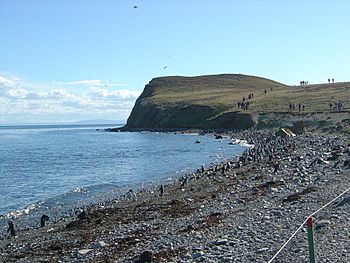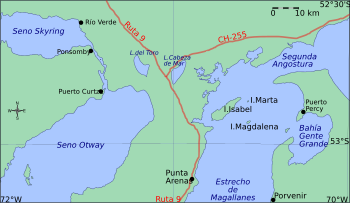Magdalena Island, Magallanes Region facts for kids
|
Native name:
Isla Magdalena
|
|
|---|---|

The penguin's colony upon the island
|
|
 |
|
| Geography | |
| Location | Strait of Magellan |
| Coordinates | 52°55′10″S 70°34′34″W / 52.91944°S 70.57611°W |
| Highest elevation | 27 m (89 ft) |
| Administration | |
|
Chile
|
|
Magdalena Island (Spanish: Isla Magdalena) is a small island located in the Strait of Magellan in Chile. It is famous for being home to a huge colony of Magellanic penguins. A small team of Park Rangers lives on the island all year to protect the wildlife. They stay in a building connected to the island's lighthouse. Magdalena Island is also part of the "End of the World Route," a popular tourist path.
Contents
Island History and Exploration
The famous explorer Ferdinand Magellan first saw this island when he sailed through the strait. One of his crew members, Antonio Pigafetta, wrote about it in his book, The First Voyage Round the World. He mentioned how they used signals to help ships find each other if they got separated.
Pigafetta wrote that they placed flags with messages. One flag was on a small hill, and another was on a tiny island nearby. This islet had many "sea wolves" (which are probably sea lions) and large birds. These signals were meant to guide any ship that might have lost its way from the main group.
Geography and Wildlife Habitat
Magdalena Island is located in the Magallanes Region of Chile. It is about 32 kilometers northeast of Punta Arenas, the region's capital city. In 1982, Magdalena Island and a nearby island called Marta Island were named a national monument. This special area is known as Los Pingüinos Natural Monument.
The island is a very important place for several kinds of seabirds to raise their young. The most well-known residents are the Magellanic penguins. Experts have been watching the penguin colony on the island since 1998. In 2007, they estimated there were about 63,000 breeding pairs of penguins living there. Besides the Park Rangers, no other people live on the island.
Magellanic Penguin Population
The number of penguins on Magdalena Island has changed over time for different reasons. Studies show that tourism is not causing the penguin numbers to drop. In fact, for a small number of penguins nesting near the tourist paths, having visitors around might even help them raise their chicks better.
The main animal that preys on penguin chicks on Magdalena Island is the Skua (Stercorarius chilensis). Skuas are very shy birds and tend to stay away from areas where tourists are present. When there are fewer Skuas in an area, more penguin chicks survive, which helps the penguin population grow.
The penguin population was around 59,000 breeding pairs in 2000/01. It grew to 63,000 pairs in 2008/09. However, by 2018/19, the number had dropped to 43,000 pairs. In 2009 and 2010, the island experienced a very bad drought. This drought killed almost all the plants, leaving only bare soil.
Without plants to hold the soil in place, strong winds blew loose dirt all over the island. This soil covered and buried many penguin burrows, eggs, and even young chicks. Because of this, very few chicks survived, and the amount of good nesting space on the island became much smaller. As a result, many penguins moved to a nearby colony at Cabo Virgenes in Argentina.
See also
 In Spanish: Isla Magdalena (Magallanes) para niños
In Spanish: Isla Magdalena (Magallanes) para niños

